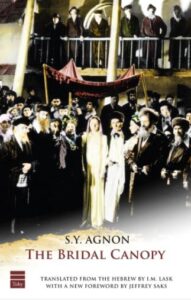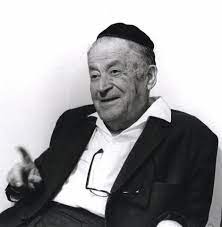The BEST: The Bridal Canopy

A reading of S.Y. Agnon’s The Bridal Canopy and its message for Purim
Summary: The Bridal Canopy, Nobel laureate S.Y. Agnon’s mock epic novel, is an elaborate frame story encompassing dozens of Hasidic tales. The narrative is decisively double-edged: naïve, in the manner of classic folk tales, as well as sophisticated and artful, as a modern work. The Bridal Canopy parodies the Hasidic folk tale, but does so very delicately; it censures without acrimony, always maintaining an air of reverence for the Old World. Unlike other depictions of Eastern European Jewry’s shtetl life, the story is sufficiently subtle to support divergent readings – and that is clearly part of Agnon’s accomplishment. Set in early nineteenth-century Galicia (today’s western Ukraine which is the focus of so much of our attention and prayers these days), the plot is part quest, part comedy of errors, progressively departing from its opening tone of realism. It is the tale of poor Reb Yudel, his long-suffering wife, Frummet, and their three modest and righteous daughters, each in need of a bridegroom.
Burdened with poverty, and the need to provide dowries, Reb Yudel sets out schnorring, to collect the requisite funds to marry the girls off. The novel’s Hebrew title, Hakhnasat Kallah, is the colloquial rabbinic expression for raising the money needed to arrange such marriages. Despite his dire financial straits, pious Reb Yudel “always sat at the holy toil of the Torah,” serving God “in awe and fear and love and never thought of acquiring honor through study or being esteemed a scholar by himself or others.” From beginning to end, Agnon maintains a sharp tension between the material and spiritual realms that serve as the two plot poles of The Bridal Canopy. Setting off in a set of borrowed clothing (the notions of disguise and mistaken identity run throughout the novel), he is led by Nuta the faithful wagon driver, who serves as a clear-headed Sancho Panza to Yudel, a kind of Judaized Don Quixote.
[Watch a recording of Jeffrey Saks teach The Bridal Canopy for the Tikvah Open University.]
Why this is The BEST? After several months of travel, punctuated by a variety of longer and shorter tales held within the frame of the main plot, Yudel and Nuta arrive in the city of Rohatyn. As part of the comedy of errors, our Yudel is mistaken for wealthy Yudel Nathanson, an historical character who makes a cameo appearance in our tale. Nathanson (d. 1832) was a renowned merchant and one of Galicia’s richest Jews. When it becomes known that he is seeking a match for his daughter, the reader can imagine the line that forms at the door, and a match is arranged with the son of the wealthiest Jew in town. (It is important to note that Reb Yudel never deceives anyone; others confuse him for the affluent banker.) Awaiting the wedding back home, Reb Yudel’s mistaken identity becomes compounded twofold, as on Purim – a day dedicated to masks, disguises, and hidden identities – a character called “Reb Yudel who is not RebYudel,” an imposter who has been posing around town, even in the very house of the rich Yudel Nathanson, regales the townsfolk with wonder tales of Reb Yudel’s travels, which, thanks to Nuta’s loose lips, have already been exaggerated into the things of legend.
 At the risk of doing a disservice to the multiple tributaries of the main narrative current by cutting the story short, Reb Yudel is revealed as the pauper he really is when the in-laws arrive for the wedding. How will our hero be saved from calamity? He responds in his typical stance of faith: God will provide. And, indeed, “salvation arises for the Jews from another (most unlikely!) place” at the final moment when a hidden treasure is discovered. That we readers understand there is a very prosaic explanation for the plot’s turn-about, Reb Yudel’s faith guides him to the only possible interpretation of God’s hand in his history.
At the risk of doing a disservice to the multiple tributaries of the main narrative current by cutting the story short, Reb Yudel is revealed as the pauper he really is when the in-laws arrive for the wedding. How will our hero be saved from calamity? He responds in his typical stance of faith: God will provide. And, indeed, “salvation arises for the Jews from another (most unlikely!) place” at the final moment when a hidden treasure is discovered. That we readers understand there is a very prosaic explanation for the plot’s turn-about, Reb Yudel’s faith guides him to the only possible interpretation of God’s hand in his history.
The piety and poverty showcased in the novel, with Torah study being the central axis around which Yudel’s life spins, were subjects of other works of modern Jewish literature, where they were usually made the subject of acerbic satire. Here Agnon is responding to that kind of corrosive construction when he creates Reb Yudel. Our author’s portrayal is not without bite, but it is drawn with a far gentler hand. Agnon always sees with a kind of double vision: simultaneously nostalgic for and critical of the Old World, neither a shill for tradition nor attempting to undermine it.
Like Don Quixote, to whom he has often been compared, Yudel set off on a journey empowered by books. Cervantes’ epic was itself a parody of chivalric literature, its protagonist a delusional old man who responds to tales of chivalrous knights by launching his own quest for knight-errantry, righting injustice, saving damsels, widows and orphans, and tilting at giants (be they only windmills). When he returns home, his housekeeper is burning his books to protect him from their fantasies, but it is too late to save him from his madness. Reb Yudel is semi-comical (like any good Purim story); Don Quixote is semi-tragic. Don Quixote is someone whose consciousness has been warped by reading. Reb Yudel, too, has read – but his books are Torah, and they have convinced him that the world works by way of miracles, because God will not disappoint His faithful.
The Bridal Canopy inspires us with the model of Reb Yudel’s faith, even as we recognize him for his ridiculousness. He helps us moderns recall a world of faith which was far simpler, but also more profound, than our own. Fourteen years after publishing The Bridal Canopy, Agnon released another novel. Widely considered to be his magnum opus, Temol Shilshom, in translation as Only Yesterday, is the story of Yitzhak Kumer, Reb Yudel’s great-great-grandson. In this work, set almost a century later, the family fortune has dissipated and young Yitzhak heads off for the Land of Israel. The lengthy novel tells the tale of his life in Palestine during the Second Aliyah (in the decade before World War I), and addresses issues of theodicy and divine justice, and the divide between religion and secular modernity, all on the dramatic backdrop of settling the land in those days. Unlike the tale of his ancestor, Yitzhak’s story is tragic (think Akedat Yitzhak without the angelic reprieve). As the narrator rehearses again and again, his tragedy can be traced, at least partially, to the fact that in Yitzhak’s generation miracles no longer occur the way they did for his great-great-grandfather, Reb Yudel, who merited divine intervention precisely because his simple faith could not conceive of a world without miracles.
The Bridal Canopy is a comedy not just in the Shakespearean sense, as it concludes with a wedding, but because despite near-ruin, everything works out in the end. This is true whether the salvation was an act of God, or merely plain dumb luck. Yudel is quite convinced of the former, while we readers understand the possible “secular” explanation of events even as the protagonist remains oblivious to it, and how such non-providential “coincidences” would render his suffering meaningless. Indeed, from Yudel’s point of view, the prolonged suffering he endures is totally offset by his elevation of the spiritual over the physical. This, of course, produces the mayhem that fuels the plot. And so, the Marx Brothers-type scene in which the rich Reb Yudel, the poor Reb Yudel, the imposter Reb Yudel who is not (really) Reb Yudel, and the wealthy in-laws are all brought together – takes place on Purim. Naturally, if a plot twist is to take place on any particular day of the year, Purim is pre-programmed for such a thing. On this holiday of masks and disguised identities, what is concealed will be revealed, and, in the end, God works it all out for the best on behalf of His faithful.
Rabbi Jeffrey Saks is the editor of TRADITION. Click here to read about “The BEST” and to see the index of all columns in this series.

